The loong story: China's zodiac animal is not the fire-breathing dragon
* Ahead of the Chinese New Year, many people have come to realize that the new zodiac animal is not the ferocious, fire-breathing dragon of the West.
* But what exactly is the Chinese dragon, or loong? Why do Chinese farmers pray to it in temples? Why do so many people adopt it as their children's given names?
* Here Xinhua offers a cultural guide for those who wish to better understand the symbolism of the Year of the Dragon -- or the Year of the Loong.
by Xinhua writers Yao Yuan and Lyu Qiuping
BEIJING -- As the Chinese New Year approaches, many Chinese people are using a word that English speakers may not be familiar with to translate the zodiac sign of the year to come -- the Year of the Dragon, or, instead, the Year of the Loong.
The word "loong" has been emblazoned on gold jewelry, gift boxes and street decorations, replacing the conventional "dragon" translation of the mythical symbol of the Chinese nation.
In south China's Hainan Province, a giant sign containing "LOONG" stands outside the Haikou International Duty-Free Shopping Complex to greet shoppers seeking luxury goods ahead of the new year. The word also appears on zodiac-themed gold bars in Caibai Jewelry, a leading gold retailer in Beijing.
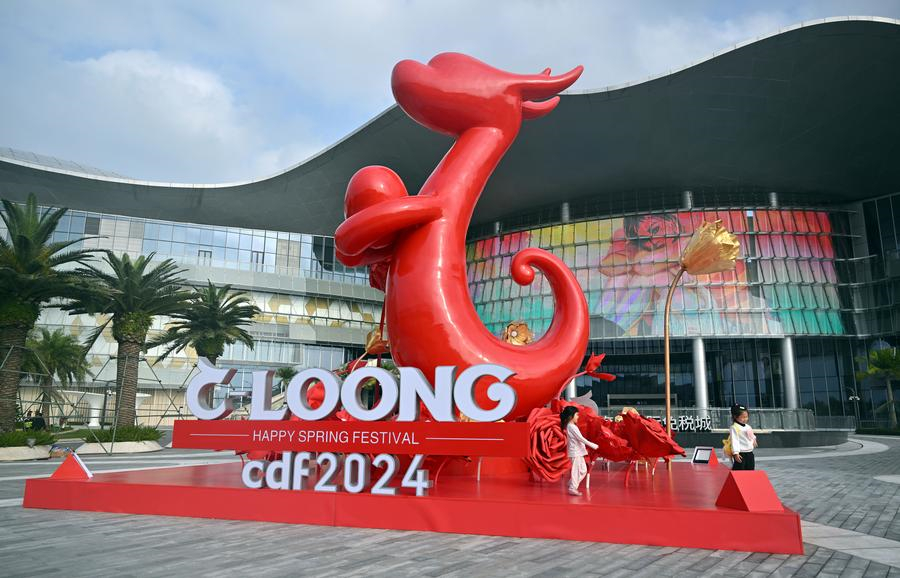
A giant sign containing "LOONG" is pictured outside the Haikou International Duty-Free Shopping Complex in Haikou, south China's Hainan Province, Feb. 1, 2024. [Xinhua/Guo Cheng]
This public endorsement of the "loong" translation is probably a result of the longstanding argument over the proper translation of the sacred creature.
"Dragon" has long been used as the translation of the Chinese word "long," pronounced similarly to "loom." But some culture mavens have been calling for a switch to "loong," a word coined in the 19th century, to dissociate the Chinese dragon from the formidable monsters of Western myth.
British sinologist Frances Wood said that she prefers to continue using the word "dragon" as it is understood on both sides, but stressed the importance of adding the modifier "Chinese."
"A Chinese dragon is a different sort of dragon from a Western dragon. It is a good creature, not a bad one," she said.
So what exactly is a Chinese dragon? And in what ways is it different from the ferocious, fire-breathing Western dragons? Xinhua has interviewed scholars, archaeologists and folk artists to offer a cultural guide for those who wish to understand the symbolism of the Year of the Dragon -- or the Year of the Loong -- a little better.
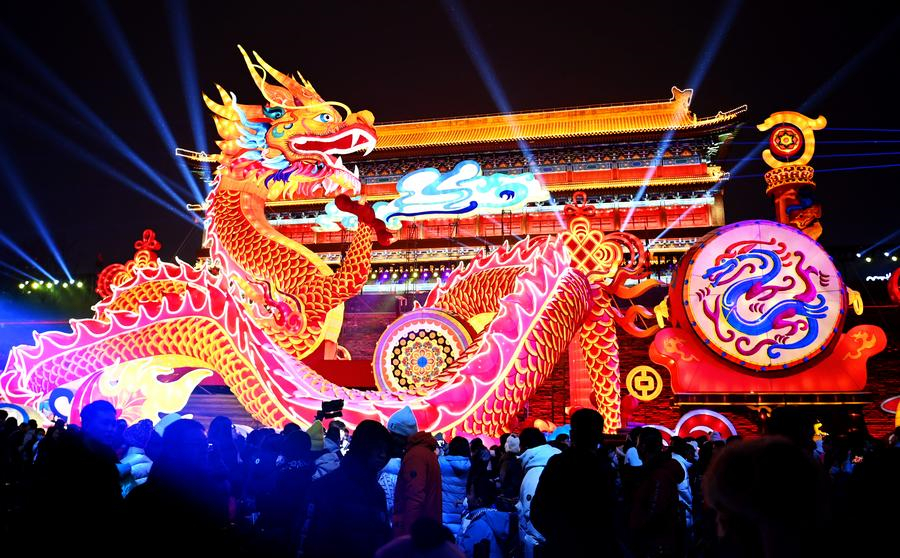
Tourists look at light decorations near the city wall of Xi'an, capital of northwest China's Shaanxi Province, Feb. 2, 2024. [Xinhua/Zou Jingyi]
CROCODILE OR SNAKE?
Western dragons are often described as giant reptiles with wings. But it is much harder to liken Chinese dragons to any existing animal.
Archaeologists are divided on the origin of the legendary animal, with snakes and crocodiles being two likely influences.
Images of the loong appeared as early as the Neolithic Age. A 6,500-year-old tomb of a sorcerer or shaman in Puyang, Henan Province, contained a loong made of clamshells that, according to some archaeologists, was modeled on a Yangtze crocodile, a small alligator that feeds on fish and rarely attacks humans.
Another famous Neolithic loong is the 5,000-year-old C-shaped jade loong unearthed in what is today known as Inner Mongolia. This legless loong bears more resemblance to a snake.
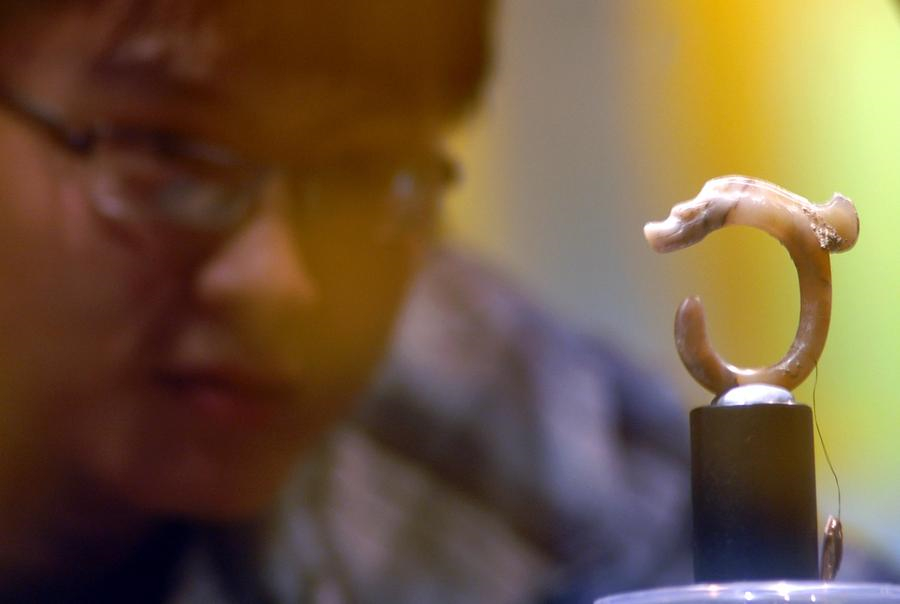
This file photo taken on April 28, 2009 shows a visitor looking at the C-shaped jade loong exhibited at the Liuzhou Museum in Liuzhou City, south China's Guangxi Zhuang Autonomous Region. [Photo by Lai Liusheng/Xinhua]
Some scholars attribute this shift in influence to changes in climate, which drove crocodiles to the south and made boas a more common sight in the northern plains of China, an important cradle of the Chinese civilization.
Entering into the Warring States Period (475-221 B.C.), the loong took on the combined characteristics of both snakes and crocodiles, and the loong image that mostly fits our imagination of the creature today first appeared during the Southern Song Dynasty (1127-1279), according to Yuan Jing, an archaeologist at the Chinese Academy of Social Sciences.
Today, a typical loong is a combination of many animal parts, including the body of a snake, the head of a horse, the talons of an eagle and the antlers of a deer. It is often portrayed flying through clouds, though it does not have wings like its European counterparts.

Participants compete during a dragon boat race in southwest China's Chongqing Municipality, June 22, 2023. [Xinhua/Huang Wei]
FIRE OR WATER?
In "Harry Potter and the Goblet of Fire," a dragon from China is named the "Chinese Fireball." In the Chinese people's imagination, however, the loong is more associated with water than with fire. Countless paintings, murals and temples depict the creature as a deity ruling oceans, rivers and rain.
"In ancient Chinese legend, the loong is the king of the water and commands the rain," said Xiong Hui, who heads the management center of the Dragon King Temple Park in Wuhan, central China's Hubei Province.
The park is home to one of the most famous dragon king temples in China, built during the Ming Dynasty (1368-1644) for people to pray for safe voyages on the Yangtze River. It is the likely origin of the Chinese saying "The flood destroys the temple of the dragon king," which means being hit accidentally by a close ally, according to Xiong.
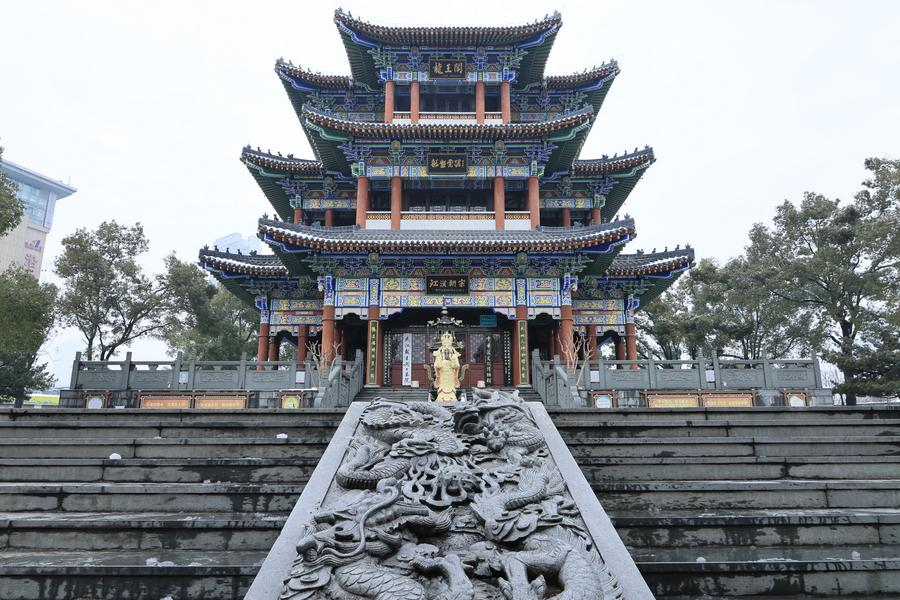
This photo taken on Feb. 7, 2024 shows a view of the Dragon King Temple Park in Wuhan, central China's Hubei Province. [Management center of the Dragon King Temple Park/Handout via Xinhua]
In drought-prone parts of China, dragon king temples are places to pray for rainfall.
The practice of praying to loongs for rain has a history of more than 2,000 years, and related rituals were so popular in the Tang and Song dynasties (618-1279) that they received royal and official sponsorship, said Kang Yuhu, an archaeologist leading the excavation of a temple in Hubei where such rituals were held.
"The belief that the loong symbolizes water is deep-rooted. Many ancient wooden holders for washbasins, for instance, bore loong carvings to bless people as they touched the water," said Yan Xinyuan, a collector and the producer of an exhibition featuring loong artifacts in Beijing.
Though the loong is typically associated with water, there are a few exceptions. In Chongqing's Tongliang District, people wear loong costumes and run through a shower of molten iron sparks in a performance called the "fire dragon dance," staged to fend off disease and ill fortune.
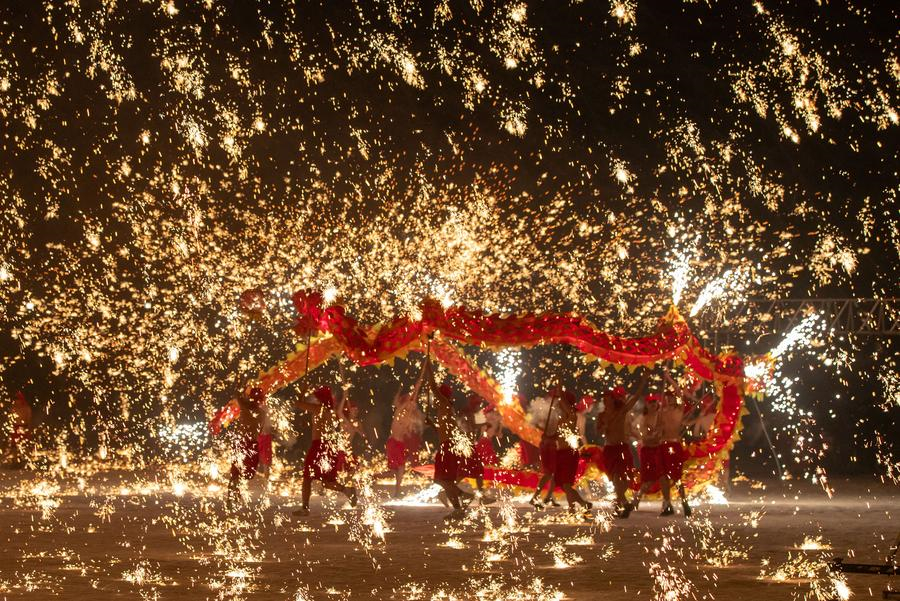
Members of a Tongliang Dragon Dance performing troupe perform "fire dragon dance" in a shower of molten iron in Harbin, northeast China's Heilongjiang Province on Jan. 29, 2024. [Xinhua/Zhang Tao]
DEVIL OR DIVINE?
James LaLonde is an American who has been living in Beijing for almost 10 years, and he has a Chinese name -- Lang Longjie, the second character of which is Long, meaning "dragon."
"I choose that name. I think it's lucky and inspiring for me," he said, noting that the character also matches his last name in its pronunciation.
"The Western dragon usually seems more of an enemy to humans," he said. "But here in China, it seems like the dragon is more friendly."
LaLonde is correct in his observation that the Chinese dragon is a sign of good fortune. It is the most auspicious among all 12 of the Chinese zodiac animals, the other 11 of which are the rat, ox, tiger, rabbit, snake, horse, sheep or goat, monkey, rooster, dog and pig.
Loong is a common given name. Most people are familiar with the martial artist and actor Bruce Lee, but not many know that his Chinese name is Lee Siu Loong.
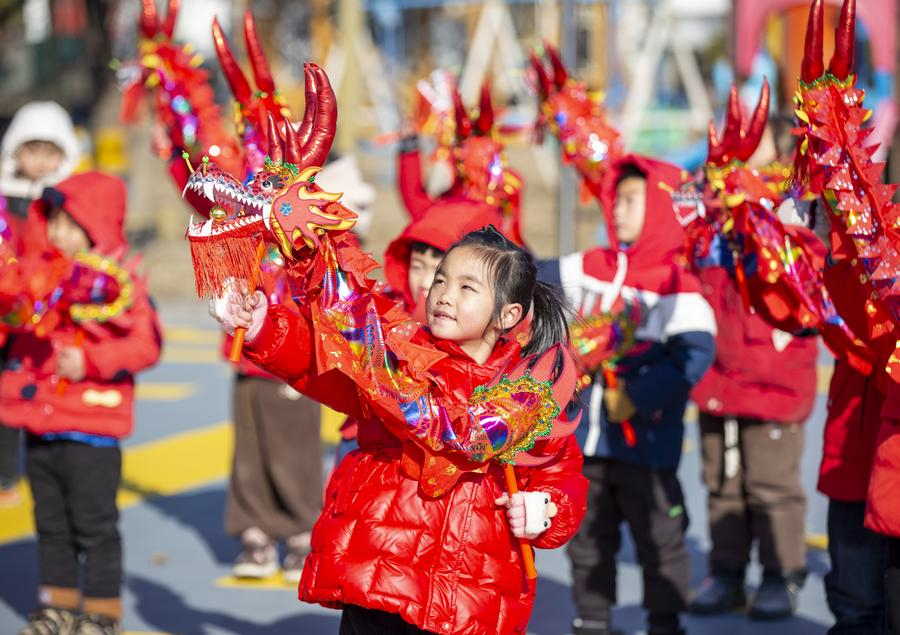
Children perform dragon dance in Hai'an City, east China's Jiangsu Province, Jan. 23, 2024. [Photo by Zhai Huiyong/Xinhua]
Dragon dances to herald good luck are commonly staged during traditional festivals, weddings and the opening ceremonies of companies.
Chinese people are considered the descendants of loongs, so there is a saying that goes, "When there are Chinese people, there are dragon dances," said Hu Kai, a professor at the China University of Geosciences (Wuhan) and an international dragon and lion dance judge.
"The dragon dance is staged to dispel disaster and pray for good luck, rain and bumper harvests. It carries the Chinese people's hopes for better lives," she said.
Huang Yaoman, Yu Pei, Yue Wenwan, Zhou Huimin, Wu Lu, Du Juan and Intern Zheng Bowen have contributed to the story. Video reporters: Huang Yaoman, Lyu Qiuping, Yao Yuan, Yu Pei, Yue Wenwan, Guo Cheng, Zhou Huimin; Video editors: Yang Zhixiang, Zhang Yuhong, Liu Ruoshi
























